13-inch Retina MacBook Pro Review (Late 2012)
by Anand Lal Shimpi on November 13, 2012 2:53 AM ESTGeneral Performance
The 13-inch rMBP is a very fast system thanks to its combination of good silicon and a very fast SSD. Anyone looking to upgrade a MacBook Pro released before 2011 will see a measurable increase in performance. Where the decision is more difficult is if you're comparing a quad-core 15-inch MBP to the dual-core 13-inch rMBP.
The 13-inch rMBP manages to boot much quicker than any other stock MacBook Pro, including the 15-inch model. Boot time is actually on par with the 2012 MacBook Air, which makes sense given the very similar internal hardware. The missing dGPU likely shaves off some pre-boot initialization time in addition to reducing the actual OS load time. The end result is a system that can boot (and reboot) incredibly quickly.

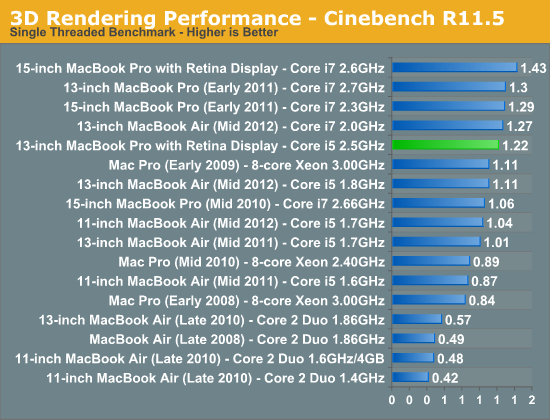
Raw CPU performance is good, but clearly behind the 15-inch rMBP. The 15-inch model I'm comparing to here is the $2799 configuration with 2.6GHz quad-core CPU (max turbo = 3.6GHz). The single threaded Cinebench 11.5 test really shows the difference in single threaded performance here (+17%) which maps almost perfectly to the difference in max turbo (+16%). I would assume that the upgraded Core i7 option for the 13-inch rMBP would erase this gap since it can also turbo up to 3.6GHz. If you're comparing to a pre-2011 15-inch MacBook Pro, the 13-inch rMBP is faster which is a good point for those looking to upgrade an older machine and want a lot more portability.
Compared to the 2012 MacBook Air, the 13-inch rMBP is slightly faster than the base configuration although it lags behind the upgraded Core i7 part in the upgraded 13 (a similarly upgraded rMBP would be faster however). This really serves to show the strength of Intel's Turbo Boost. Even though the MBA ends up using 17W parts, available thermal headroom allows it to hit clock speeds that equal the 13-inch rMBP.

Although single threaded performance is clearly competitive, it's multithreaded performance where the quad-core 15-inch rMBP really pulls ahead. The multithreaded Cinebench 11.5 test really shows the best case scenario for the 15-inch rMBP, but there are still big deltas if we look at our video transcoding tests using iMovie:
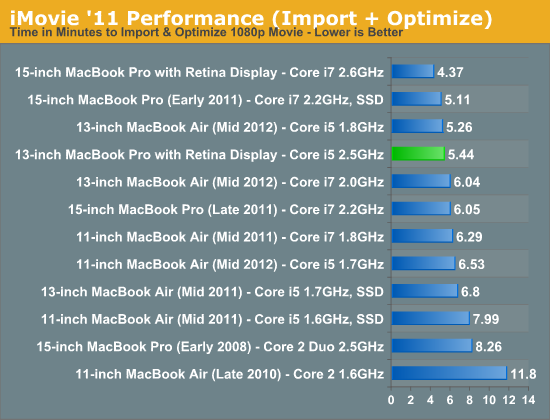
Importing isn't as heavily threaded and thus the performance advantage for the quad-core 15 is only 24%.
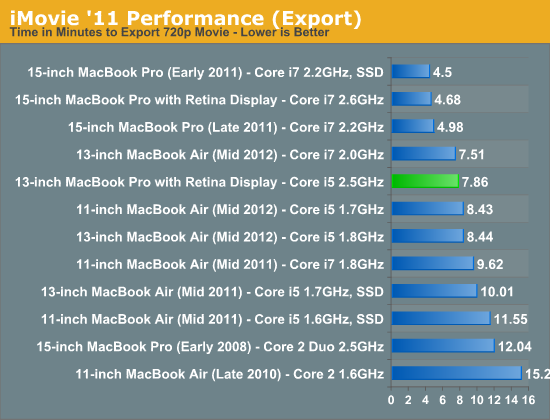
The export task takes 75% longer however.
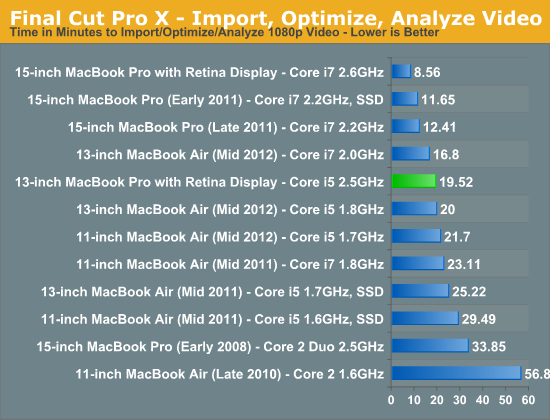
If you're an active Final Cut Pro X user, you'll want to opt for the 15-inch rMBP. The added performance offered by twice the cores (and in this case, even higher clocks) just can't be ignored. Anyone doing real video work is going to want four cores.
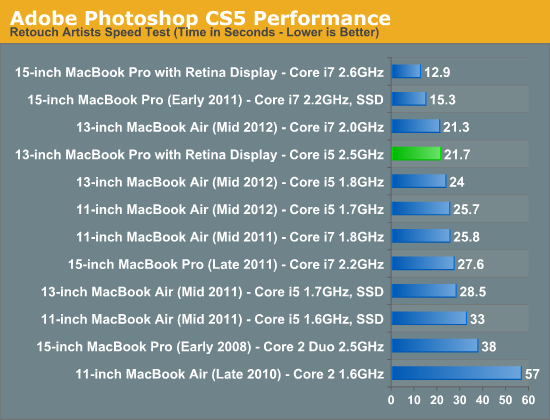

Our photo workloads are no less forgiving. The 13-inch rMBP is clearly a fast machine thanks to its integrated SSD, but the 15-inch model is just significantly faster. The MacBook Air comparison is very close across the board. Although there's more thermal headroom offered by the 13-inch rMBP chassis, max turbo frequencies are very similar between the MBA and 13-inch rMBP models which results in peak performance looking very similar. What makes the 13-inch rMBP a "Pro" machine is really about the display first, not performance.










79 Comments
View All Comments
KPOM - Tuesday, November 13, 2012 - link
The 13" MacBook Pro always had a dual core processor and never had discrete graphics. The Retina version is no different in that regard. If it isn't a "Pro" than neither is the non-Retina version.As an 11" MacBook Air user, the weight difference and extra thickness are more noticeable to me. Hopefully Apple comes out with an 11" MacBook Pro with Retina Display, since it does look very nice (I saw one in the store and it blew away the screen on my Air).
Arbee - Tuesday, November 13, 2012 - link
Agreed. Much as the original Air was basically an engineering placeholder waiting for SNB to make it good, this seems to be a placeholder waiting for at least Haswell, and possibly Broadwell.jeffbui - Tuesday, November 13, 2012 - link
Anand, your aspect ratio chart is off. The MBPs are still 16:10jeffbui - Tuesday, November 13, 2012 - link
Oops, looks like you switched the 16:9 chart with the 16:10 chart.iwod - Tuesday, November 13, 2012 - link
I wonder why Apple do not all stick to the same 16:10 ratio. The New iMac is 16:9, while all notebook are 16:10.Aenean144 - Wednesday, November 14, 2012 - link
iMacs have >20 inch screens. When you get that big, there's enough vertical screen space so that wider aspect ratio screens are tolerable.For smaller screen laptops, vertical space is at a premium. 16:10 is at best a compromise to me. Going to 16:9 would make it less usable.
yserr - Tuesday, November 13, 2012 - link
I have a MBP 15" (no Retina). I'm willing to give up GPU or quad, but not both, for portability.Do you think haswell will bring quad core to the 13" MBPr.
I think with the dismiss of the 17" and the trend to smaller, light devices. The 15" will be the new 17" and the 13" will be the new 15".
The 15" rMBP has two soldered ram banks the 13" rMBP has one.
Are there 16GB modules which are reasonable priced for one bank (which apple could offer)?
I will wait for haswell and than decide between 13" and 15".
My dream machine will be 13" rMBP with 16GB Ram and quad.... so I hope haswell will deliver my dream :-)
iwod - Tuesday, November 13, 2012 - link
Quad Core as standard and 2x Graphics Improvement. That is what i am hoping for as well. But with the 4x increase in Pixel count i doubt even Haswell is even good enough in Graphics Department. I just hope Broadwell will bring at least 3x performance over Haswell.yserr - Tuesday, November 13, 2012 - link
At least you see here (http://bit.ly/PalAfy - Haswell Preview) on the haswell slides that they will support 4k and High Resolution Displays. Lets see if they can deliver the performance needed for that. No question Broadwell will be better than Haswell. I hope Haswell will be fast enough for my needs.Kevin G - Tuesday, November 13, 2012 - link
Actually Ivy Bridge does support 4K displays if they are being driving by two DP.Haswell will implement DP 1.2 so it will be able to drive a 4K resolution display over a single cable. The GT3 + eDRAM versions of Haswell should be able to handle accelerated GUI without much issue. Gaming on the other hand at such high resolutions is something even high end GPU's (Radeon 7970, GTX 680) are struggling with.